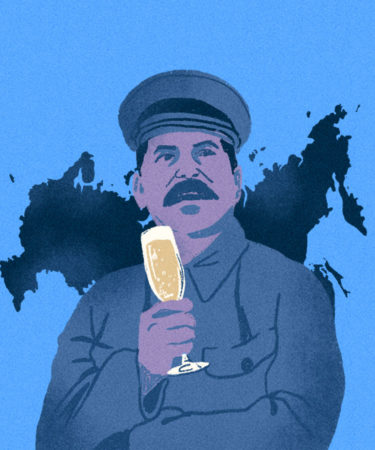Despite its reputation for exclusivity, sparkling wine is produced around the world. Southern Europe sees the production of Cava in Spain and Italy’s beloved Prosecco, while Western Europe is home to German Sekt and, of course, France’s renowned Champagne.
The world’s largest country may not be the first — nor second, third, or even fourth — place that comes to mind when speaking of notable sparkling wines. But in Russia, a country perhaps better known for its love of vodka, a homegrown sparkling wine has been sating rossiyane thirst for more than 80 years. Trademarked as Sovetskoye Shampanskoye, the so-called “Soviet Champagne” became popular in one of history’s darkest times in the early 20th century.
Although Russian wine production can be traced thousands of years to the ancient Greeks, it wasn’t until the 18th century that “a proper wine culture” took hold, reports Beverage Trade Network’s London Wine Competition, when “Peter the Great and Empress Elizabeth II acquired a taste for Champagne and fine wines from Europe.”
Later in the 19th century, Prince Leo Golitsyn, deemed the “founder of Russian Champagne,” according to travel company Russia Way In, produced sparkling wines made from European grape varieties at Novyi Svet (its English translation is “New World”), a winery in Crimea set along the Black Sea. Prince Golitsyn would eventually oversee Abrau-Durso, an estate established for the primary purpose of supplying sparkling wine to Czar Alexander II and his household.
But after the Bolshevik Revolution and establishment of the Soviet Union in 1922, Russia’s agricultural industries fell on hard times, grinding sparkling wine production to a halt.
With Soviet society racked by famine and poverty, Joseph Stalin looked for ways to demonstrate the fulfillment of his promise of a new Soviet era. One of his unlikely vehicles became Champagne, a symbol of bourgeois excess. Fixated on the unlikely goal of making Champagne available to the starving masses, Stalin forced unrealistic expectations on an already shaky industry. The Soviet government facilitated Stalin’s scheme to increase sparkling wine production by millions of bottles through an unprecedented 1936 resolution.
“The idea was to make things like Champagne, chocolate, and caviar available at a rather cheap price, so that they could say that the new Soviet worker lived like the aristocrats in the old world,” Jukka Gronow, author of “Caviar with Champagne: Common Luxury and the Ideals of the Good Life in Stalin’s Russia,” told Atlas Obscura in 2019.
In the 1930s, Anton Frolov-Bagreev, a winemaker and former student of Prince Golitsyn, created a recipe and technique for large-scale sparkling wine production. Contrary to the time-consuming traditional method, also known as the Champagne method (which requires two fermentations in bottle), Frolov-Bagreev’s process focused on efficiency. Dubbed the continuous method, the wine was fermented in a series of pressurized tanks instead of in bottle, and would be utilized by Russian factories to mass-produce bubbly. Unable to recreate the taste that time afforded Champagne, this also meant Soviet sparkling wine producers often added sweeteners to mask the wine’s blemishes.
But none of this deterred Soviet palates. In the decades that followed, Sovetskoye Shampanskoye became ubiquitous in big cities, and an essential component of celebrations. Although Russian producers finally agreed to stop illegally labeling their wines in 2011, Soviet Champagne firmly secured a place in Russian’s collective heart. And nearly a decade later, it appears some brands — including Novyi Svet — still use the term “shampanskoe” on their labels, claiming it is “permitted as long as they only use the Cyrillic alphabet.”
